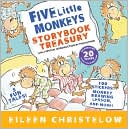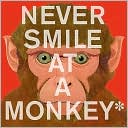Kids seem to love monkeys - drawing them, watching them, visiting them at the zoo, even wearing them on their clothes. These two books will surely not disappoint your little monkey-lovers!
 Christelow, Eileen.
Christelow, Eileen.Five Little Monkeys Storybook Treasury.
August 2009.
Houghton Mifflin Harcourt.
Guided Reading Levels:
Five Little Monkeys Jumping on the Bed: E
Five Little Monkeys Sitting in a Tree: F
Five Little Monkeys with Nothing to Do: I
Five Little Monkeys Wash the Car: I
Summary from Barnes & Noble:
This 20th-anniversary treasury features a special introduction and five full-length picture books—Five Little Monkeys Jumping on a Bed, Five Little Monkeys Bake a Cake, Five Little Monkeys Sitting in a Tree, Five Little Monkeys with Nothing to Do, and Five Little Monkeys Wash the Car—as well as a lesson on how to draw your own fabulous monkeys. Sheets of colorful stickers and musical notation round out this amazing collection. It’s the perfect addition to any child’s classic library.
I've always loved Five Little Monkeys Jumping on a Bed and Five Little Monkeys Sitting in a Tree, but wasn't familiar with the other three stories included in this treasury. They're every bit as good as the first two counting-themed stories and I know kids will love them! There's so much that can be done with these stories that they're definitely a choice I'd want to see on school, classroom and home library shelves.
Activities to Use in Collaboration with this book:
- Five Little Monkeys Jumping on the Bed - Simple subtraction activity. Using construction paper, cut out the shape of a bed. Allow children to decorate the bedspread on their bed by coloring it. Pair students off. Give each pair of students some monkey manipulatives, similar to these. Using the Five Little Monkeys Jumping on the Bed worksheet, students will write number sentences after manipulating the monkeys. They will place 5 monkeys on the bed. Some number fall off and bump their heads. How many are left on the bed. ____-_____=_____. They will continue to do this until they have created all of the possible combinations that start with 5 monkeys on the bed until all five fall off. 5-0=5, 5-1=4, 5-2=3, 5-3=2, 5-4=1, 5-5=0. With older or more advanced students, you could have them do fact families to make the activity level a bit higher.
- Five Little Monkeys Sitting in a Tree - Jenn, from Ramblings of a Crazy Woman created these craft stick monkeys and an alligator to use with this story. They could be used to for retelling and sequencing the events of the story, or could be used as puppets when singing the song.
- Five Little Monkeys with Nothing to Do - This is a writing activity. Children will pretend they are one of the five little monkeys with nothing to do. All of their chores are done. Their homework is done. If they could do anything in the world, what would they choose to do? Write in your journal, 5-6 sentences answering this question. Be sure to use sentences, complete with capital letters and punctuation!
- Five Little Monkeys Bake a Birthday Cake - After reading the story, provide children with this writing activity. Obviously these five little monkeys have no idea how to make a birthday cake. Let's see if you can help them! Write step-by-step directions for "How to Make a Birthday Cake." Read all of the writing samples that are turned in. The student who provides the directions closest to those needed to actually bake a cake "wins," however, the whole class will really win. That student gets to choose which kind of cake the class will bake - chocolate, vanilla, or strawberry and what kind of icing to frost the cake with. Then, together as a class, prepare, bake and enjoy the cake!
- Five Little Monkeys Wash the Car - The five little monkeys are washing the car because they want to help their mother sell it so they can buy a new one. Organize a class car wash to raise money for a good cause. This will help children see the importance of giving back to the community and working as a team to accomplish a goal.
 Jenkins, Steve.
Jenkins, Steve.Never Smile at a Monkey: And 17 Other Important Things To Remember.
October 2009.
Houghton Mifflin Harcourt.
Summary from Barnes & Noble:
When it comes to wild animals, everyone knows that there are certain things you just don’t do. It's clearly a bad idea to tease a tiger, pull a python's tail, or bother a black widow spider. But do you know how dangerous it can be to pet a platypus, collect a cone shell, or touch a tang fish? Some creatures have developed unusual ways of protecting themselves or catching prey, and this can make them unexpectedly hazardous to your health. In this dynamic and fascinating picture book by Steve Jenkins, you'll find out what you should never do if you encounter one of these surprisingly dangerous animals.
Steve Jenkins' books take on a whole new approach to children's non-fiction. Had these been around when I was young, I would probably be infatuated with non-fiction... however, even though I wasn't that fortunate, today's children are! This book provides today's children with so many interesting facts about things you should never do to/with animals! Definitely a great book to share!
Activity to Use in Collaboration with this book:
- Assign each child one of the animals from the book. In addition to the information found within this book, ask the child to research and find more information about the animal, completing the research worksheet attached here, courtesy of West Hartford Public Schools. Once they have done that, assign a creative writing project to the student(s). The writing assignment is for children to create a story with the title, "I __________ a ___________," filling in the blanks with whatever animal and the advice Jenkins gave not to do. Children then need to be creative in coming up with a story about this animal and all that they learned about the animal. An example can be found here. I gathered my black bear information from Wikipedia for time's sake, but certainly you'd want students to consult a variety of resources to gather their information before completing the writing assignment.








0 comments:
Post a Comment